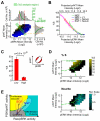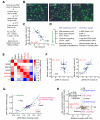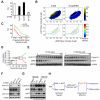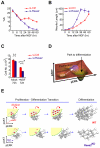A two-dimensional ERK-AKT signaling code for an NGF-triggered cell-fate decision
- PMID: 22206868
- PMCID: PMC3897208
- DOI: 10.1016/j.molcel.2011.11.023
A two-dimensional ERK-AKT signaling code for an NGF-triggered cell-fate decision
Abstract
Growth factors activate Ras, PI3K, and other signaling pathways. It is not well understood how these signals are translated by individual cells into a decision to proliferate or differentiate. Here, using single-cell image analysis of nerve growth factor (NGF)-stimulated PC12 cells, we identified a two-dimensional phospho-ERK (pERK)-phospho-AKT (pAKT) response map with a curved boundary that separates differentiating from proliferating cells. The boundary position remained invariant when different stimuli were used or upstream signaling components perturbed. We further identified Rasa2 as a negative feedback regulator that links PI3K to Ras, placing the stochastically distributed pERK-pAKT signals close to the decision boundary. This allows for uniform NGF stimuli to create a subpopulation of cells that differentiates with each cycle of proliferation. Thus, by linking a complex signaling system to a simpler intermediate response map, cells gain unique integration and control capabilities to balance cell number expansion with differentiation.
Copyright © 2012 Elsevier Inc. All rights reserved.
Figures







Comment in
-
Cellular signal processing: out of one, many.Mol Cell. 2012 Jan 27;45(2):143-4. doi: 10.1016/j.molcel.2012.01.004. Mol Cell. 2012. PMID: 22284673
Similar articles
-
NGF promotes cell cycle progression by regulating D-type cyclins via PI3K/Akt and MAPK/Erk activation in human corneal epithelial cells.Mol Vis. 2012;18:758-64. Epub 2012 Mar 30. Mol Vis. 2012. PMID: 22509106 Free PMC article.
-
Nerve Growth factor regulation of cyclin D1 in PC12 cells through a p21RAS extracellular signal-regulated kinase pathway requires cooperative interactions between Sp1 and nuclear factor-kappaB.Mol Biol Cell. 2008 Jun;19(6):2566-78. doi: 10.1091/mbc.e06-12-1110. Epub 2008 Mar 26. Mol Biol Cell. 2008. PMID: 18367547 Free PMC article.
-
Nerve growth factor inhibits Na+/H+ exchange and formula absorption through parallel phosphatidylinositol 3-kinase-mTOR and ERK pathways in thick ascending limb.J Biol Chem. 2008 Sep 26;283(39):26602-11. doi: 10.1074/jbc.M803019200. Epub 2008 Jul 25. J Biol Chem. 2008. PMID: 18660503 Free PMC article.
-
Multiple signaling conduits regulate global differentiation-specific gene expression in PC12 cells.J Cell Physiol. 2004 Dec;201(3):459-69. doi: 10.1002/jcp.20087. J Cell Physiol. 2004. PMID: 15389548
-
Cytotoxic effects of acrylamide in nerve growth factor or fibroblast growth factor 1-induced neurite outgrowth in PC12 cells.Arch Toxicol. 2014 Mar;88(3):769-80. doi: 10.1007/s00204-013-1174-6. Epub 2013 Dec 7. Arch Toxicol. 2014. PMID: 24318646
Cited by
-
Single cell spatial biology over developmental time can decipher pediatric brain pathologies.Neurobiol Dis. 2024 Sep;199:106597. doi: 10.1016/j.nbd.2024.106597. Epub 2024 Jul 9. Neurobiol Dis. 2024. PMID: 38992777 Review.
-
Defective axonal transport of Rab7 GTPase results in dysregulated trophic signaling.J Neurosci. 2013 Apr 24;33(17):7451-62. doi: 10.1523/JNEUROSCI.4322-12.2013. J Neurosci. 2013. PMID: 23616551 Free PMC article.
-
A guide to ERK dynamics, part 2: downstream decoding.Biochem J. 2023 Dec 13;480(23):1909-1928. doi: 10.1042/BCJ20230277. Biochem J. 2023. PMID: 38038975 Free PMC article.
-
Model scenarios for cell cycle re-entry in Alzheimer's disease.iScience. 2022 Jun 7;25(7):104543. doi: 10.1016/j.isci.2022.104543. eCollection 2022 Jul 15. iScience. 2022. PMID: 35747391 Free PMC article.
-
Can Blood-Circulating Factors Unveil and Delay Your Biological Aging?Biomedicines. 2020 Dec 15;8(12):615. doi: 10.3390/biomedicines8120615. Biomedicines. 2020. PMID: 33333870 Free PMC article. Review.
References
-
- Albert R. Scale-free networks in cell biology. Journal of cell science. 2005;118:4947–4957. - PubMed
-
- Arias AM, Hayward P. Filtering transcriptional noise during development: concepts and mechanisms. Nat Rev Genet. 2006;7:34–44. - PubMed
-
- Bar-Sagi D, Feramisco JR. Microinjection of the ras oncogene protein into PC12 cells induces morphological differentiation. Cell. 1985;42:841–848. - PubMed
Publication types
MeSH terms
Substances
Grants and funding
LinkOut - more resources
Full Text Sources
Miscellaneous

